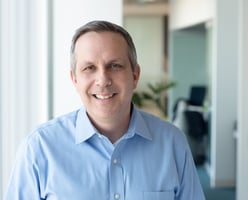Meet Kate Lawver, Convergent's Vice President of Pre-Construction

At Convergent Energy and Power (Convergent), the pre-construction phase is vital to the seamless execution of our renewable energy solutions, including energy storage (typically in the form of battery storage) and solar photovoltaics (PV). As part of our commitment to delivering solutions efficiently and safely, the Pre-Construction team lays the groundwork for successful system outcomes by ensuring all necessary planning, design, and risk mitigation strategies are in place before construction begins.
We sat down with Kate Lawver, Convergent’s Vice President of Pre-Construction, to learn more about her role in overseeing the crucial early stages of project development and how her leadership contributes to Convergent’s success in the renewable energy industry.
[The following Q&A has been edited for clarity and brevity.]

Q: What makes the pre-construction phase crucial to the success of renewable energy solutions like energy storage and solar PV?
A: Pre-construction is the bridge between fast-paced sales and deeply technical construction. Our team speaks both languages fluently, which means we’re constantly translating between stakeholders, engineers, developers, utilities, and local authorities.
Pre-construction is full of resilient problem-solvers. We encounter new and recurring challenges every day—technical, interpersonal, communicational, and regulatory. We work with diverse teams that often don’t speak the same technical or cultural language, so we step in as moderators and translators to keep projects on track.
And we keep the end in mind meaning while specialists might focus on civil, electrical, or financial details, Pre-construction looks at the entire system lifecycle—from concept to decommissioning—and asks: What does this site/system need to succeed for the long haul? That’s the lens we bring to every decision.
Q: Can you tell us about your journey to becoming Vice President, Pre-Construction at Convergent?
A: You could say my path here has come full circle—and it’s been a little unconventional. I actually got my start in renewable energy thanks to my father, who owned and ran a renewable energy company. As an only child, I spent a lot of time with him at work. But instead of giving me crayons and coloring books, he was the kind of dad who taught me residential solar design at eight years old—and let me work on real projects, checking my work, of course. That experience sparked a deep love of clean technology early on.
My father’s projects were ahead of their time—carbon-neutral housing, solar PV, solar thermal, geothermal, combined heat and power. We didn’t just work with homeowners; we worked with agricultural and small Commercial and Industrial (C&I) customers across the Appalachian region, where energy reliability and affordability were serious challenges. We even used large-scale batteries in the early 2000s to try to provide cleaner, more dependable power to underserved communities.
When I officially joined the company, I started in the field as both an installer and designer. That hands-on experience taught me how hard it is to install some of the “beautiful” but impractical designs I’d created. That dual perspective gave me a ton of respect for construction teams and helped me grow into a much better engineer.
After that, I moved into small utility-scale solar and battery projects—rooftop, ground mount, carport—you name it. I became Director of Operations, but I missed being close to the design process, so I took a step back to go deeper into engineering. At Borrego, I was a Senior Design Engineer Manager, managing projects from start to finish, literally drawing every detail in AutoCAD.
That’s also where one of my more unconventional ideas took shape. My manager and I noticed that engineers tended to fall on one side of the scale: those who thrive on specificity and clear direction, and those who loved tackling ambiguous, complex problems. Together, we proposed splitting the team into Development and Construction Engineering. I’m known—sometimes unfortunately—for my “unique ideas,” but this idea of how to split the teams really worked. It boosted efficiency, sales, and overall performance so much that Borrego allowed the newly formed Development team to operate independently from its EPC counterpart. I was promoted to Director of Development Engineering.
Eventually, Borrego sold the Development branch and shifted its focus toward large utility-scale systems. That pivot brought me here, to Convergent. It’s been a wild, rewarding journey—from helping my dad fabricate custom solar racking as a kid (some of my outlandish ideas even made it into our builds!) to helping solve some of the industry’s toughest pre-construction challenges today.
Q: What specific challenges do you face in the pre-construction phase, and how does your team tackle them?
A: You have to genuinely love problem-solving to work in pre-construction. Fortunately, we do. Roadblocks pop up, and we meet them with curiosity—not frustration. Honestly, it’s hard to think of a type of challenge that we may not encounter.
When we develop systems, we’re generally working in a new community. To help build trust in these communities, we start by showing up and listening —engaging with local communities through town halls, public meetings, stakeholder consultations, and by testing our talking points with focus groups from within those communities. We’re there to understand their concerns and educate—often using third-party research or data to show we’re committed to transparency and safety without biases.
From there, we bring concerns to the Authority Having Jurisdiction (AHJ) or the boards we’re working with and negotiate conditions of approval that align with national codes while working closely with the desires of the community. We can’t eliminate every risk, but we do everything we can to minimize those risks both responsibly and safely.
Good, clear, empathetic communication is everything. We interact with so many different people with varied job roles, expertise, and backgrounds. Being a great communicator is essential to navigating all of it successfully.
Q: We’ll get back to your role and the energy sector momentarily, but first, we’d love to know how you like spending your time outside of the office?
A: Animals and nature have always been a huge part of my life—and honestly, they’re a big reason I work in the energy sector. I had an externship as a zookeeper at ZooAmerica in Hershey, PA, which deepened my love for ecology. My parents also bred and trained golden retrievers and German shepherds when I was growing up, so I’ve been around animals for as long as I can remember.
I learned a lot from working with animals—especially about communication. Animals won’t adapt to your way of communicating, so you have to learn to meet them where they are. That lesson’s stayed with me and helped me become a better communicator in all areas of life.
Now, I have three Shiloh shepherds, and my fiancé and I built out an off-grid overlanding van to spend time in nature whenever we can. It’s our way of recharging—literally and figuratively.

I also spent nearly 20 years as a professional gymnast, and that’s what eventually led me to volunteer with the Special Olympics in women’s artistic gymnastics. I love working with those athletes. They’re fearless, determined, and incredibly diverse in how they approach challenges. It taught me so much about motivation, adaptability, and, again, the importance of communication. It was one of the most enriching experiences of my life.
Q: How does your role in pre-construction support Convergent’s commitment to the clean energy transition?
Pre-construction is where many of the most polarizing challenges in renewable energy first show up. It’s the phase where deal-breakers are discovered—and either resolved or not. That’s where our team comes in. We’re creative, agile, and maybe a little unconventional—but we get things done.
We don't stop at the first “no.” We ask: What’s Plan B? Or Plan C? We thrive on those tough moments because they’re opportunities to move projects forward in new ways.
Pre-construction also plays a unique role as the cog in the feedback wheel of the organization. We take what we learn from completed systems and integrate it with new technology and evolving best practices. We’re constantly optimizing for performance, safety, cost, constructability, and long-term operations—often all at once. It’s like answering questions for every team in the company, but through one lens.
At the end of the day, Pre-construction helps Convergent build smarter, safer, and more scalable systems—and that’s what the clean energy transition needs.
———–
Is Energy Storage or Solar PV Right for Your Business or Utility?
Please contact us if you would like to learn more about how energy storage, with or without solar PV, can benefit your business or community.



